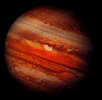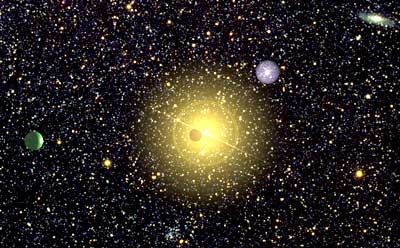

|
Jupiter
- Overall properties: The name comes from the king of the gods, Zeus / Jupiter;
The planet's radius is 11.2 Earth radii, with a rotation period 10 hr, and the radius of its orbit is 5.20 AU
[with a period 11.9 years]; It is more massive than all
other planets put together.
- Missions: Flybys by Pioneer 10
and 11 in 1973-1974, and by Voyager
1 and 2 in 1979; Orbited by Galileo in 1995-2003 (then plunged!); The Juno spacecraft is currently on its way;
Future ones will focus on its moons.
- Clouds: It is covered by circulating,
global colored cloud bands, with turbulent
changing patterns and a Great Red Spot (a thunderstorm larger than
Earth, due to a changing high pressure region, at least 300 years old)
and many smaller spots; Powered by internal heat and the Sun.
- Moons: It has the
most complex system of moons known, with moons very different from each other,
like a miniature solar system: Four Galilean moons, Io (volcanos), Europa
(ice; water?), Ganymede (the largest in the Solar System, icy), and Callisto
(similar); a total of 67 known, some as small as 1 km across, some retrograde,
probably captured asteroids.
- Rings: Thin, made of rock fragments and dust,
located inside the moons' orbits.
|


![]()